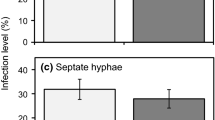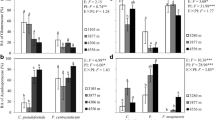Abstract
Most vascular plants form symbioses with mycorrhizal fungi that associate with roots and provide nutrients to hosts in exchange for carbohydrates, as well as serve a range of other functions. Mycorrhizal fungi have been studied extensively in upland ecosystems, but we know less about their ecology at aquatic-terrestrial interfaces, especially their distributions at depth. Our objectives were to determine whether abundances of arbuscular mycorrhizal fungi (AMF) change as floodplain islands develop and to describe vertical distributions of AMF from the forest floor to the water table along the freely flowing Tagliamento River in northeastern Italy. We sampled surface sediments (0–10 cm) from three stages of island development on the floodplain—fresh deposits, pioneer islands, and established islands. We also sampled sediments vertically (0–150 cm) from the ground surface to the water table on an established island. We characterized abundance of AMF propagules (colonized roots, spores, and hyphae) within sediments. Roots available to host fungi were absent on fresh deposits; however, some viable spores and hyphae were available at these sites. Pioneer and established islands each had similar hyphal lengths (~860 cm cm−3) and colonized root lengths (~3 cm cm−3). Abundance of spores increased from depositional (3.5 ± 0.9 (±SE) cm−3) to pioneer (17 ± 6.1 cm−3) to established (32 ± 6.3 cm−3) islands. On an established island, AMF propagules were present at all depths sampled, including at the water table, providing first documentation of these symbionts to such depths in a riparian setting. Mycorrhizal fungi likely link aquatic and terrestrial habitats by connecting plants, soil, and ground water and may influence nutrient transfers among these subsystems.




Similar content being viewed by others
References
Beauchamp VB, Stromberg JC, Stutz JC (2006) Arbuscular mycorrhizal fungi associated with Populus-Salix stands in a semiarid riparian ecosystem. New Phytol 170:369–380
Beauchamp VB, Stromberg JC, Stutz JC (2007) Flow regulation has minimal influence on mycorrhizal fungi of a semi-arid floodplain ecosystem despite changes in hydrology, soils, and vegetation. J Arid Environ 68:188–205
Brundrett MC, Melville L, Peterson RL (1994) Practical Methods in Mycorrhiza Research, Mycologue Publications. Waterloo, Canada, p 161
Edwards PJ, Kollmann J, Gurnell AM, Petts GE, Tockner K, Ward JV (1999) A conceptual model of vegetation dynamics on gravel bars of a large Alpine river. Wetlands Ecol Manage 7:141–153
Gardes M, Bialet E, Binet E, Brousseau C, Carré F, Charcosset J, Fradet N, Griffith P, Gryta H, Laquerbe M, Martinez C, Millot S (2003) Les symbiotes mycorhiziens du peuplier noir (Populus nigra L.): la spécificité des assemblages fongiques en milieu riverain. Les Actes du BRG 4:453–466
Gurnell AM, Petts GE, Hannah DM, Smith BPG, Edwards PJ, Kollmann J, Ward JV, Tockner K (2001) Riparian vegetation and island formation along the gravel-bed Fiume Tagliamento, Italy. Earth Surf Proc Land 26:31–62
Gurnell A, Tockner K, Edwards P, Petts G (2005) Effects of deposited wood on biocomplexity of river corridors. Frontiers Ecol Environ 3:377–382
Harner MJ, Ramsey PW, Rillig MC (2004) Protein accumulation and distribution in floodplain soils and river foam. Ecol Lett 7:829–836
Harner MJ, Piotrowski JS, Lekberg Y, Stanford JA, Rillig MC (2009) Heterogeneity of mycorrhizal inoculum potential in flood-deposited sediments. Aquat Sci 71:331–337
Harner MJ, Mummey DL, Stanford JA, Rillig MC (2010) Arbuscular mycorrhizal fungi enhance spotted knapweed growth across a riparian chronosequence. Biol Invasions 12:1481–1490
van der Heijden MGA, Bardgett RD, van Straalen NM (2008) The unseen majority: soil microbes as drivers of plant diversity and productivity in terrestrial ecosystems. Ecol Lett 11:296–310
Jacobson KM (2004) The effects of flooding regimes on mycorrhizal associations of Populus fremontii in dryland riparian forests. In: Cripps C (ed) Fungi in forest ecosystems: diversity. Systematics and Ecology, New York Botanical Gardens, New York, pp 275–280
Karrenberg S, Edwards PJ, Kollmann J (2002) The life history of Salicaceae living in the active zone of floodplains. Freshw Biol 47:733–748
Kemper WD, Rosenau RC (1986) Aggregate stability and size distribution. In: Klute A (ed) Methods of soil analysis (Part 1). American Society of Agronomy, Madison, pp 425–442
Klironomos JN, Hart MM (2002) Colonization of roots by arbuscular mycorrhizal fungi using different sources of inoculum. Mycorrhiza 12:181–184
Lodge DJ (1989) The influence of soil moisture and flooding on formation of VA-endo- and ectomycorrhizae in Populus and Salix. Plant Soil 117:243–253
McGonigle TP, Miller MH, Evans DG, Fairchild GL, Swan JA (1990) A new method which gives an objective measure of colonization of roots by vesicular-arbuscular mycorrhizal fungi. New Phytol 115:495–501
Morris MR, Brouwer BB, Caves JK, Harner MJ, Stanford JA (2010) Successional changes in soil and hyporheic nitrogen fertility on an alluvial flood plain: implications for riparian vegetation. Aquat Sci. doi:10.1007/s00027-010-0153-8
Naiman RJ, Bechtold JS, Beechie TJ, Latterell JJ, Van Pelt R (2010) A process-based view of floodplain forest patterns in coastal river valleys of the Pacific Northwest. Ecosystems 13:1–31
Nakamura F, Shin N, Inahara S (2007) Shifting mosaic in maintaining diversity of floodplain tree species in the northern temperate zone of Japan. For Ecol Manag 241:28–38
Nakatsubo T (1997) Effects of arbuscular mycorrhizal infection on the growth and reproduction of the annual legume Kummerowia striata growing in a nutrient-poor alluvial soil. Ecol Res 12:231–237
Oehl F, Sieverding E, Ineichen K, Ris E, Boller T, Wiemken A (2005) Community structure of arbuscular mycorrhizal fungi at different soil depths in extensively and intensively managed agroecosystems. New Phytol 165:273–283
Piotrowski JS, Lekberg Y, Harner MJ, Ramsey PW, Rillig MC (2008) Dynamics of mycorrhizae during development of riparian forests along an unregulated river. Ecography 31:245–253
Rillig MC (2004a) Arbuscular mycorrhizae and terrestrial ecosystem processes. Ecol Lett 7:740–754
Rillig MC (2004b) Arbuscular mycorrhizae, glomalin, and soil aggregation. Can J Soil Sci 84:355–363
Rillig MC, Mummey DL (2006) Mycorrhizas and soil structure. New Phytol 171:41–53
Rillig MC, Field CB, Allen MF (1999) Soil biota responses to long-term atmospheric CO2 enrichment in two California annual grasslands. Oecologia 119:572–577
Smith SE, Read DJ (2008) Mycorrhizal symbiosis, 3rd edn. Academic Press, San Diego, p 800
Stanford JA, Lorang MS, Hauer FR (2005) The shifting habitat mosaic of river ecosystems. Verh Internat Verein Limnol 29:123–136
Stutz JC, Beauchamp VB, Johnson J, Kennedy LJ, Richter BS, Jacobson KM (2009) Mycorrhizal ecology. In: Stromberg JC, Tellman B (eds) Ecology and conservation of desert riparian ecosystems: the San Pedro River example. University of Arizona Press, Tucson, Arizona, pp 73–88
Tockner K, Ward JV, Arscott DB, Edwards PJ, Kollmann J, Gurnell AM, Petts GE, Maiolini B (2003) The Tagliamento River: a model ecosystem of European importance. Aquat Sci 65:239–253
Treseder KK, Cross A (2006) Global distributions of arbuscular mycorrhizal fungi. Ecosystems 9:305–316
Van der Nat D, Tockner K, Edwards PJ, Ward JV, Gurnell AM (2003) Habitat change in braided flood plains (Tagliamento, NE-Italy). Freshw Biol 48:1799–1812
Van Pelt R, O’Keefe TC, Latterell JJ, Naiman RJ (2006) Riparian forest stand development along the Queets River in Olympic National Park, Washington. Ecol Monogr 76:277–298
Vierheilig H, Coughlan AP, Wyass U, Piché Y (1998) Ink and vinegar, a simple staining technique for arbuscular-mycorrhizal fungi. Appl Environ Microbiol 64:5004–5007
Virginia RA, Jenkins MB, Jarrell WM (1986) Depth of root symbiont occurrence in soil. Biol Fertil Soils 2:127–130
Vozzo JA, Hacskaylo E (1974) Endo- and ectomycorrhizal associations in five Populus species. Bull Torrey Botan Club 101:182–186
Ward JV, Tockner K, Edwards PJ, Kollmann J, Bretschko G, Gurnell AM, Petts GE, Rossaro B (1999) A reference river system for the Alps: The ‘Fiume Tagliamento’. River Res Appl 15:63–75
Warner NJ, Allen MF, MacMahon JA (1987) Dispersal agents of vesicular–arbuscular mycorrhizal fungi in a disturbed arid ecosystem. Mycologia 79:721–730
Whited DC, Lorang MS, Harner MJ, Hauer FR, Kimball JS, Stanford JA (2007) Climate, hydrologic disturbance, and succession: drivers of floodplain pattern. Ecology 88:940–953
Zajicek JM, Hetrick BAD, Owensby CE (1986) The influence of soil depth on mycorrhizal colonization of forbs in the tallgrass prairie. Mycologia 78:316–320
Zanoni L, Gurnell A, Drake N, Surian N (2008) Island dynamics from analysis of historical maps and air photographs. River Res Appl 24:1141–1159
Acknowledgments
We thank Dr. Angela Gurnell for discussions about island development and the ecology of the Tagliamento River and the Alexander von Humboldt Foundation for funding research through a postdoctoral fellowship to MJH.
Author information
Authors and Affiliations
Corresponding author
Rights and permissions
About this article
Cite this article
Harner, M.J., Opitz, N., Geluso, K. et al. Arbuscular mycorrhizal fungi on developing islands within a dynamic river floodplain: an investigation across successional gradients and soil depth. Aquat Sci 73, 35–42 (2011). https://doi.org/10.1007/s00027-010-0157-4
Received:
Accepted:
Published:
Issue Date:
DOI: https://doi.org/10.1007/s00027-010-0157-4




